Menu
Close
Here you can add some health background details which can be useful in setting the scene. GO!
Values are what make you who you are – see how you understand what values are compared to beliefs and then enter your values. GO!
You can take a health questionnaire to see how healthy you are. GO!
See how your attitude to change can affect whether you make changes to your health. GO!
You locus of control determines whether you are a victim of circumstance or whether you are in control. GO!
We split your overall health into a number of different ‘domains’. You can see what these domains are and find out which you are stronger in by taking an overall health questionnaire – GO!
Having established how healthy you are across all the health domains, you can now prioritise which domains you might want to address – GO!
Within each domain there are a number of specific health areas. You can look at the health areas in each domain and also see more information on each health area – GO!
Having looked at the different health areas, you can list the ones you want to tackle – GO!

bollocks nothing there
Null 1
89 1a
2
3
health_area_to_review 4
Health area to review 5
6
7
8
9
89 10
WP_Error 11
WP_Error 12
Null 13
{term@taxonomy=health_area} 14
You will be able to see the content below initially, but before you can add any personal content you will need to enter the personal password which we sent you on email – this will allow you to enter and see this personal content.
When you created your health record, you entered a password. You’ll need to enter that to be able to add and see details.
You will also have to refresh the page – F5 on Windows machines or refresh in the browser.
You are not allowed to see this content.
You have to click the button above to see the password screen
The following sections summarise your overall health. You can complete as many as you like, and in any order, but in many ways it makes more sense to progress down the page. Only enter what you feel comfortable putting in. No-one else will be able to see your info.
Once you have entered your personal password on this screen, you will have to hit ‘Refresh’ (F5 on many Windows machines) to have access to personal info.
You can enter more details about yourself, only to make your profile more complete. You can even add a profile picture! We won’t look at it, use it or do anything with it at all!
This just starts you thinking about your health – feel free to add details at any time.

This button toggles the form – press it to make it (dis)appear!
The form to update your health background is currently hidden.
The following sections summarise your overall health. You can complete as many as you like, and in any order, but in many ways it makes more sense to progress down the page. Only enter what you feel comfortable putting in. No-one else will be able to see your info.
Once you have entered your personal password on this screen, you will have to hit ‘Refresh’ (F5 on many Windows machines) to have access to personal info.
You can enter more details about yourself, only to make your profile more complete. You can even add a profile picture! We won’t look at it, use it or do anything with it at all!
This just starts you thinking about your health – feel free to add details at any time.

Your values form your attitudes on life and determine how you think, the decisions you make and what you do. It’s important to understand what they are – we help you to do that and give you choices in how to do it.
What’s the difference between values, attitudes and beliefs? To find out more click the link below.

When you want to add your values, click the button below. Then you’ll see some options for choosing your values. Decide how you want to do it, then go for it.
Your behaviour is governed by your attitudes and values. You can work out what these are, either by taking an online questionnaire, downloading a list and working out which apply to you, or just listing what you feel is important to you.
This button toggles the form – press it to make it (dis)appear!
The form to add / edit your values is currently hidden - click the button to show it.
Your values form your attitudes on life and determine how you think, the decisions you make and what you do. It’s important to understand what they are – we help you to do that and give you choices in how to do it.
What’s the difference between values, attitudes and beliefs? See more by clicking the button below.

When you want to add your values, click the button below. Then you’ll see some options for choosing your values. Decide how you want to do it, then go for it.
Your behaviour is governed by your attitudes and values. You can work out what these are, either by taking an online questionnaire, downloading a list and working out which apply to you, or just listing what you feel is important to you.
This is where you look at your current state of health overall. This might involve taking a health questionnaire, and there are three to consider. The first two you can download or do on our site – the third you have to do on their site.

When you want to have a look at your overall health, click the button below. Then you’ll see some options for doing this.
This button toggles the form – press it to make it (dis)appear!
This is where you look at your current state of health overall. This might involve taking a health questionnaire, and as explained there are three to consider. The first two you can download or do on our site – the third you have to do on their site.
You only want a quick overview of your health and wellness, and will drill down in any areas needing work – use the Subjective Happiness Scale
You want to do a more detailed assessment and then focus on areas you’re already aware of – use the Oxford Happiness Scale
You want to look at your health across a number of different domains – use the Personal Wellness Questionnaire.
When you want to have a look at your overall health, click the button below. Then you’ll see some options for doing this.
This is where you look at your attitude to change. This is important – if you want to actually do something to improve your health, you have to make changes! You may know this already, but if not you can take a questionnaire to find out or confirm your view of what your attitude to change is.

When you want to determine your attitude to change, click the button below. Then you’ll see some options for choosing how to do it.
This button toggles the form – press it to make it (dis)appear!
The attitude to change form is currently hidden.
This is where you look at your attitude to change. This is important – if you want to actually do something to improve your health, you have to make changes! You may know this already, but if not you can take a questionnaire to find out or confirm your view of what your attitude to change is.

When you want to determine your attitude to change, click the button below. Then you’ll see some options for choosing how to do it.
This is where you look at your locus of control. This is important and determines a lot about you. It’s whether you’re a passenger in life or someone who takes control. You can take a questionnaire to find out what your locus of control is.

When you want to determine your locus of control, click the button below. Then you’ll see some options for choosing how to do it.
This button toggles the form – press it to make it (dis)appear!
The Locus of Control form is currently hidden.
This is where you look at your locus of control. This is important and determines a lot about you. It’s whether you’re a passenger in life or someone who takes control. You can take a questionnaire to find out what your locus of control is.

When you want to determine your locus of control, click the button below. Then you’ll see some options for choosing how to do it.
Health is a big subject – we’ve used physical, financial and mental health to split it up.
It can be broken down into more ‘domains’ which reflect different sorts of health.
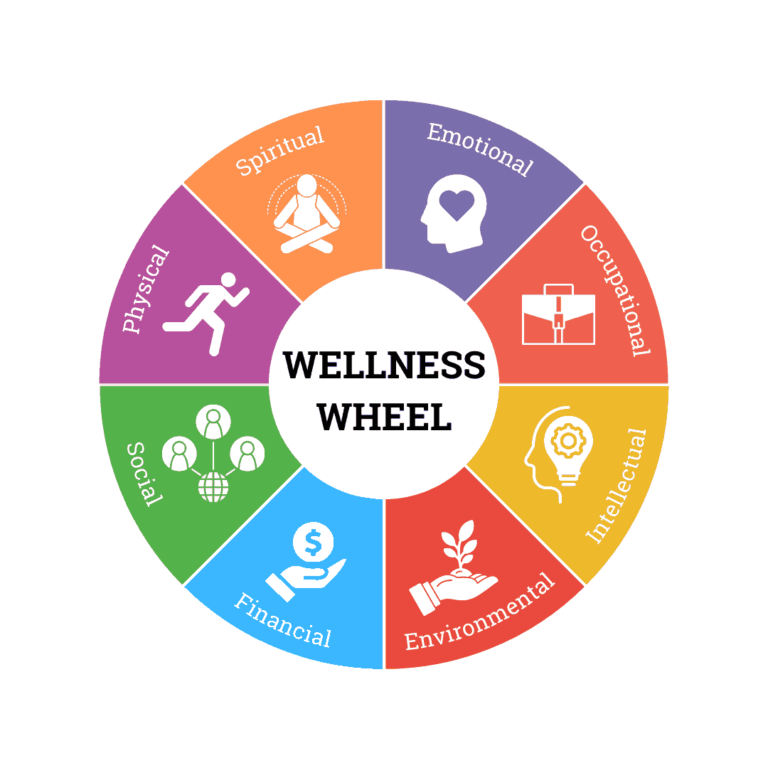
You firstly need to decide how you want to assess how your health relates to the domains. You can complete an overall health questionnaire (6 simple questions in each domain) which will give you an indication of which areas or domains you are stronger and weaker in, or go to the domains themselves and assess which are strong and weak for you, or both.
This button toggles the form – press it to make it (dis)appear!
The domains questionnaire form is currently hidden.
Health is a big subject – we’ve used physical, financial and mental health to split it up. It can be broken down into more ‘domains’ which reflect different sorts of health.

You firstly need to decide how you want to assess how your health relates to the domains. You can complete an overall health questionnaire (6 simple questions in each domain) which will give you an indication of which areas or domains you are stronger and weaker in, or go to the domains themselves and assess which are strong and weak for you, or both.
This is where you have to think about which domains you want to focus on. It isn’t always the domains where you feel you are weakest or the lowest score from the questionnaire!
There’s also the question of how important a domain is to you.
So we ask you to look at the domains you should address (the weaker ones) AND the domains you want to address.
We do this by putting domains into quadrants – click the button below to prioritise your domains.

This button toggles the form – press it to make it (dis)appear!
The domains prioritisation form is currently hidden.
This is where you have to think about which domains you want to focus on. It isn’t always the domains where you feel you are weakest or the lowest score from the questionnaire!
There’s also the question of how important a domain is to you.
So we ask you to look at the domains you should address (the weaker ones) AND the domains you want to address.
We do this by putting domains into quadrants – click the button below to prioritise your domains.
This is where you review the domains and all the health areas within them. We will be adding further health areas constantly.
The domains are listed in alphabetical order, as are the health areas within them. You can select a few health areas you might want to look at – these will appear in a list. You can then have a look at the supporting information for that health area, one at a time.

This button toggles the form – press it to make it (dis)appear!
The form to look at health areas in each domain is currently hidden.
You had a first look at the health areas within each domain, and the ones you chose to list are shown below.
You can edit the health areas you’ve selected and may want to look at by clicking the button saying ‘Click here to have a look at health areas in domains’ above.
We have a page with information on each health area. If you select a domain and health area you’ll be able to go and look.
This button toggles the form – press it to make it (dis)appear!
The form to review health areas is currently hidden.
You had a first look at the health areas within each domain, and the ones you chose to list are shown below.
You can edit the health areas you’ve selected and may want to look at by clicking the button saying ‘Click here to have a look at health areas in domains’ above.
We have a page with information on each health area. If you select a domain and health area you’ll be able to go and look.
This button toggles the form – press it to make it (dis)appear!
The form to review health areas is currently hidden.
You can now need to select the first domain and health area you want to address.
You do this by choosing the domain, then click ‘Select’ in the Possible First Area. This will open up a full list of all domains, with their health areas under the domain name. Scroll down until you see the domain you have selected, then click on the health area you want to address.
The domains are in alphabetical order and within each domain the health areas are also in alphabetical order as you have seen previously.
If you want to prioritise a second health area, then click ‘Yes’ in Select another health area to consider.
Then follow the same process to select your second domain and health area, and if you want a third and fourth. You can even leave additional ones as well if you want by clicking ‘Add further domains and health areas’. You can edit these after.
This button toggles the form – press it to make it (dis)appear!
The form to select your health areas to focus on is currently hidden.
You can now need to select the first domain and health area you want to address.
You do this by choosing the domain, then click ‘Select’ in the Possible First Area. This will open up a full list of all domains, with their health areas under the domain name. Scroll down until you see the domain you have selected, then click on the health area you want to address.
The domains are in alphabetical order and within each domain the health areas are also in alphabetical order as you have seen previously.
If you want to prioritise a second health area, then click ‘Yes’ in Select another health area to consider.
Then follow the same process to select your second domain and health area, and if you want a third and fourth. You can even leave additional ones as well if you want by clicking ‘Add further domains and health areas’. You can edit these after.
Click the button below to see how we decided which ‘domains’ to divide overall health or wellness into
Action plans are where you choose a specific issue and start to tackle it. It will be focussed on one specific health area, and you will log the issue you want to address and the ideal outcome you want. You will be able to look at some exercises you can undertake related to this issue, and decide whether you want to include these in your action plan.
In future you will be able to enlist the help of experts in the specific area you have selected – browse the experts with the relevant skills and contact the one you want to use.
Finally you will be able to log how often you tackle a particular activity and how useful you found it.
This is where you will be able to see a summary of any action plans you have created, and you will be able to go to them from there. You will also be able to add a new action plan.
You need to scroll down to see all the info in this popup – sorry for going on so much!
One definition of health is:
Health is a state of complete physical, mental and social well-being and not merely the absence of disease or infirmity.
The NHS define health as: ‘We use a broad definition of health that encompasses both physical and mental health, as well as wellbeing. This means we are not only interested in whether or not people are ill or have a health condition, but also in how healthy and well they are.’
We believe we also have to consider financial health, as this can easily impact physical and mental health. Click the button to see an example of how these are connected.
It gets more complicated…
The Active Wellbeing Society (TAWS) define Health as a state of the overall mental and physical state of a person; the absence of disease. They define Wellbeing or wellness as a way of life that aims to enhance well-being and refers to a more holistic whole-of-life experience which also includes emotional and spiritual aspects of life. We expand on this definition of health to include financial health and mental health, to make it synonymous with wellbeing or wellness.
You need to scroll down to see all the info in this popup – sorry for going on so much!
We all have our beliefs, attitudes and values – these have developed throughout our life based on who we are and what we have done. Let’s look at what these are.
The University of Reading explain: “People’s values, beliefs and attitudes are formed and bonded over time through the influences of family, friends, society and life experiences. So, by the time you’re an adult, you can hold very definite views on just about everything with a sense of “no one is going to change my mind”.
The combination of your personal values, beliefs and attitudes are your moral principles that guide you in life and affect your behaviour. However, your views can wildly differ to others and in an institution such as a school, these beliefs may be counter to the values of the school, child development or indeed the law.”
Let’s look more closely at the differences between beliefs, attitudes and values.
These come from real experiences – we think our beliefs are based on reality, but in fact our beliefs colour our experiences; also, an original experience e.g. when we were a child is not the same as what’s happening now. Beliefs can be moral, religious or cultural and reflect who we are. They can be rational (‘it gets colder in winter’) or irrational (‘I am never going to make something of myself’).
This is an immediate belief or disposition about something specific. It is a recurring group of beliefs and behaviours aimed at specific groups, people, ideas or objects. They will normally be positive or negative and we will always behave that way to the target group. Examples of attitudes include confidence (I can or can’t do something), grateful (I an entitled to / grateful for XXX) and cheerful (I am generally happy / miserable).
These are things (principles or qualities) that we hold in high regard or consider to be worthwhile or right / wrong. They are formed by a belief related to the worth of something – an idea or behaviour. Some values are common (e.g. family comes first, the value of friendship) or cultural (which the whole community have – see video at Study.com here)
Expectancy Value Theory suggests you balance your beliefs about something with the value you attach to it. The Theory of Reasoned Action suggests that beliefs and evaluation about behavioural outcomes determine attitudes, and intentions lead directly to behaviour.
Expressions of confidence – can change over time
Learned predispositions to something – are subject to change
Ideals that guide our behaviour – Generally long lasting and often need life changing experience to change
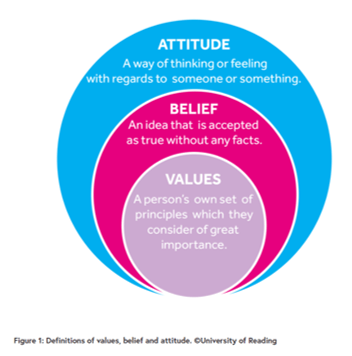
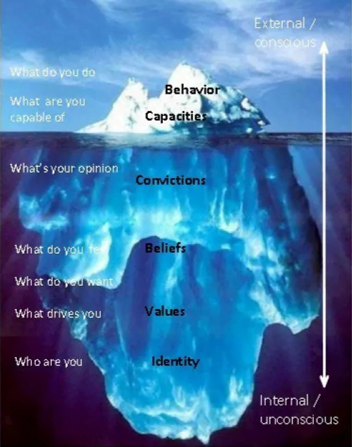
Iceberg demonstrating implicit and explicit bias – from Owlcation
You need to scroll down to see all the info in this popup – sorry for going on so much!
At YouDrive we try and help people improve their health. We use ‘health’ but we understand there are other terms such as wellbeing or even happiness that reflect how we are doing in our lives – if you’re interested in the different definitions and ideas see our page on the subject.
We want to help whether you have a particular problem – physical, financial or mental – or if you just want to improve some specific part of your life or just make some improvements overall.
You’d be surprised, but there has been a serious amount of scientific work done in this area over the last twenty years.
So first we allow you to assess your current health (or wellbeing, or happiness). We do this by questionnaire. Which one is determined by the type of person you are:
By the way, we take your privacy seriously – we collect information that you choose to provide but we de-identify it as much as possible and will never share it with anyone without your explicit consent.
You can then drill down into some specific areas and there are more questionnaires to see your situation in these particular areas. We provide you with specific information and refer you to other potential aspects of help. Our next step is to build a personalised action plan – for now we will make a suggestion for you to develop your own plan and then after a time you can see whether this has had a positive impact by retaking the test.
In future we will be engaging with medical and behavioural specialists to devise action plans for individual people with specific situations.
We have an overall questionnaire which you can complete which will assess your current state.
You need to scroll down to see all the info in this popup – sorry for going on so much!
No matter how healthy you are at the moment, the chances are that there are some areas you could improve. It may be that you have a real problem in one or more areas, and you would like to make some improvements.
At YouDrive we accept that there are many different degrees of ‘not wellness’ in a large number of different health areas, ranging from physical illness such as covid-19 through mental illness such as anxiety through to financial problems like debt. We try and help where the problem ranges from ‘slight’ to quite bad’ – after this expert help and intervention may be needed.
However, especially in these times, we have to try and make these changes ourselves, possibly with some help from others, whether remotely or face to face.
The thing is, to make an improvement we have to change some things.
This involves changing our behaviour in some respects, and that’s not always easy.
Henry Ford, the creator of the assembly line, is quoted as saying “if you always do what you’ve always done, you’ll always get what you’ve always got”.

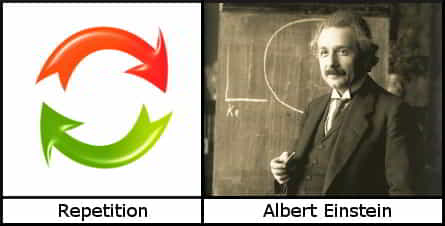
Another way of looking at this: “The definition of insanity is doing the same thing over and over again and expecting a different result.” – attributed to Albert Einstein.
Consequently we need to make some changes. The problem is that we have already developed a lot of habits, some of which we need to break and replace by better ones. Some of our bad habits have become entrenched, and the bad results they create in turn engender further bad habits to develop – in effect the bad habits can feed on themselves.
We need to understand how we can make changes and stick to them, and that’s what this part of your health profile is about.
It will involve some learning, through reading, some videos and some additional information and also seeing how you react to change currently.
It will also ask you to consider whether you feel you are in charge of your future, or whether you feel it’s all fate.
You need to scroll down to see all the info in this popup – sorry for going on so much!
People look at things differently. Some people believe things happen to them, while others believe they can influence what happens to them. Technically this is called the ‘locus of control’. People can have an Internal or external Locus of Control
Psychology Today have a 15 minute test which gives you a summary of your position you can buy the detailed results if you want to.
My Personality Test have a 10 minute test which gives you a summary.
People tend to take more responsibility (locus gets more internal) as they get older. However, external isn’t always bad – for example if you are physically unable to do some things you can accept it and focus on the things you can do. This American video explains the concept and gives examples of how this can affect relationships.
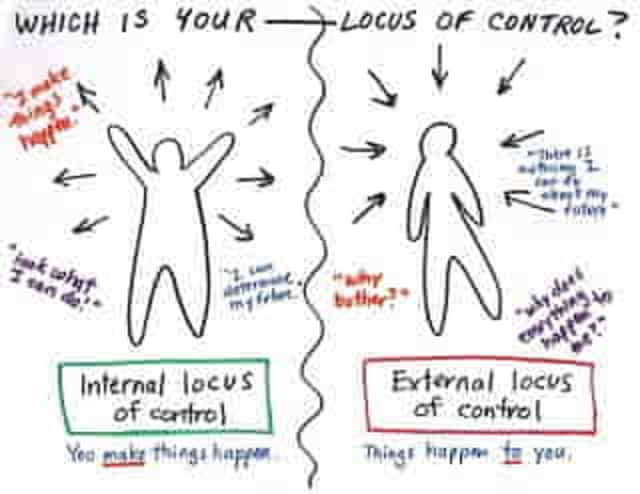
You need to scroll down to see all the info in this popup – sorry for going on so much!
We break down the overall concept of health or wellness into ‘bite-sized chunks’ that we can actually do something about. The first level we call health domains.
We like the Life of Wellness site and we have chosen the following domains.
1. Emotional Wellness: Awareness and acceptance of feelings
2. Spiritual Wellness: A search for meaning and purpose
3. Intellectual Wellness: Recognition of your creativity, knowledge and skills
4. Physical Wellness: Need for physical activity and balanced nutrition
5. Environmental Wellness: Positive awareness and impact on your environment
6. Financial Wellness: Debt reduction, cash flow balance or financial future planning
7. Occupational Wellness: Personal achievement and enrichment from your career
8. Social Wellness: Contribution to your community
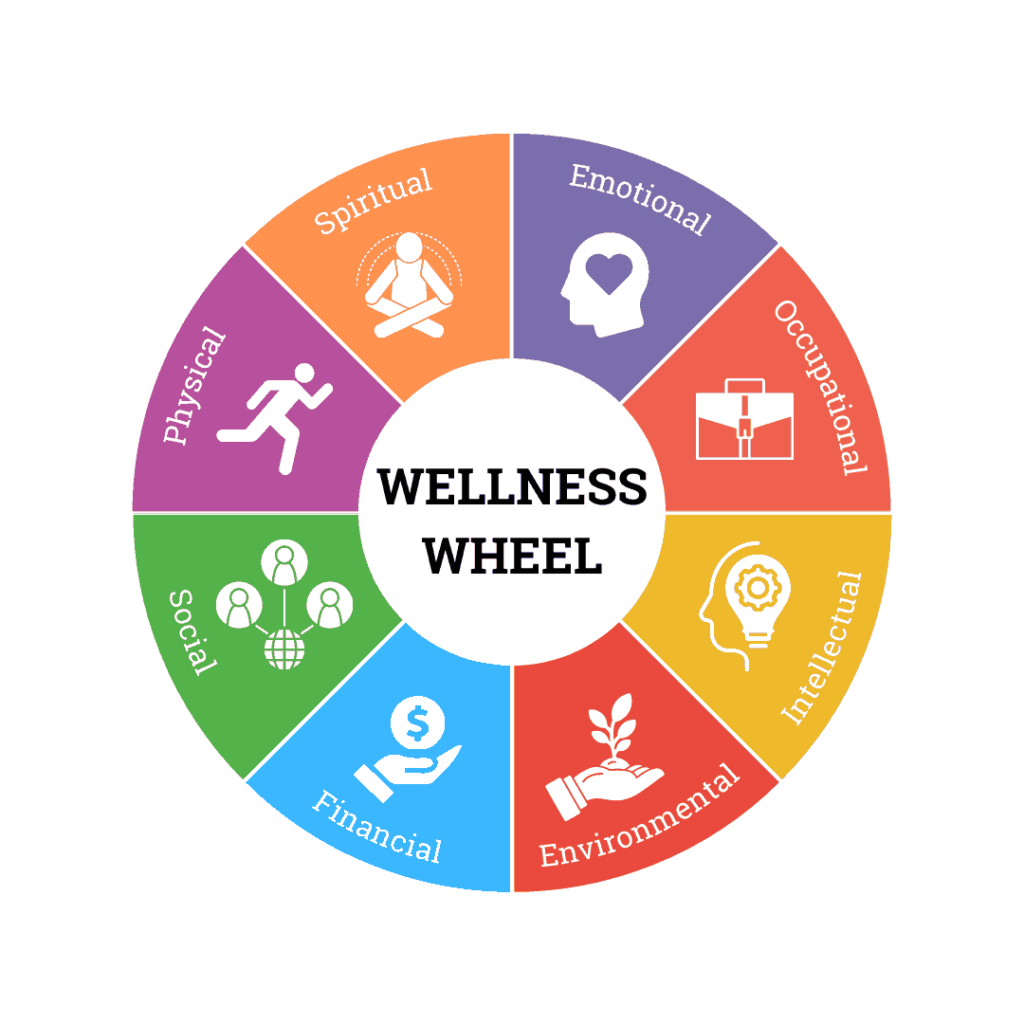
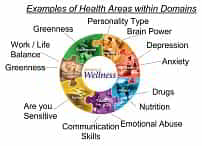
Within each domain, we have included a number of health areas. These are specific issues that you can tackle. Within each health area, e.g. Depression, once you have subscribed we have built additional information and exercises which you can do to help in the area.
You need to scroll down to see all the info in this popup – sorry for going on so much!
Having established that we use 8 domains, you need to understand which you should concentrate on.
The 8 are:
You can take a questionnaire, which scores you in each domain. You can decide which domains you are strong in, and which you need to improve.
Another analysis shows which domains you should look at, but also which domains you want to look at.
You need to scroll down to see all the info in this popup – sorry for going on so much!
We break down the overall concept of health or wellness into ‘bite-sized chunks’ that we can actually do something about. The first level we call health domains.
We like the Life of Wellness site and we have chosen the following domains.
1. Emotional Wellness: Awareness and acceptance of feelings
2. Spiritual Wellness: A search for meaning and purpose
3. Intellectual Wellness: Recognition of your creativity, knowledge and skills
4. Physical Wellness: Need for physical activity and balanced nutrition
5. Environmental Wellness: Positive awareness and impact on your environment
6. Financial Wellness: Debt reduction, cash flow balance or financial future planning
7. Occupational Wellness: Personal achievement and enrichment from your career
8. Social Wellness: Contribution to your community
Within each domain, we have included a number of health areas. These are specific issues that you can tackle. Within each health area, e.g. Depression, we have built additional information and exercises which you can do to help in the area. You can create your own Action Plan to address this area, and see
Emotional: Anxiety, Compassion Fatigue, Depression, Gambling, Laughter, Narcissistic, Personality Disorder, Sleep, Stress
Environmental: Environmental Issues, Greenness
Financial: Debt, Family Finance, Financial Planning, Financial Wellness
Intellectual: IQ, Personality, Procrastination
Occupational: Jobs for Different Personality Types, Retirement Income, Work Life Balance
Physical: Alcohol, Disabilities, Dizziness, Drugs, Fitness, Food Preferences, General Health, Healthy Ageing, Illness, Nutrition, Sleep Apnea, Smoking
Social: Communication Skills, Communication Styles, Domestic Abuse, Emotional Abuse, Love Partnerships, Mental Abuse, Parenting Styles, Sexual Addiction
Spiritual: Are You Sensitive, Mystical Guidance, Spirituality
Each health area has supporting information and its own questionnaire.
You need to scroll down to see all the info in this popup – sorry for going on so much!
You might think that physical, financial and mental health are quite separate, and for some people they are. However, often a problem in one area has a knock-on effect on others. Losing your job can lead to anxiety and depression, which can turn you to drink and impact your health.
You might have a severe issue in one area but that can lead to problems in other areas, and the people treating you for the first problem won’t be equipped to deal with these linked issues.
For example, doctors and nurses can treat you for a physical problem but can’t advise you about your job or finances. Nor for the anxiety that comes with it, apart from prescribing some drugs, which might or might not be the best solution.
We encourage you to take a holistic view – we look at all areas and offer support across the whole spectrum.
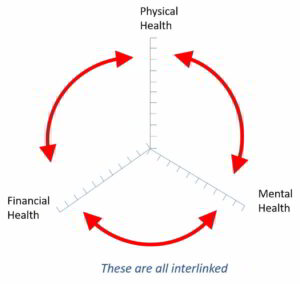
Even this view of health is simplistic, as you’ll discover later if you go down that route. You might want to consider overall health, or wellness or wellbeing, which include additional types of health, such as occupational health (how you are in your job). Then there’s happiness and quality of life – how do these fit?
If you’re interested in that, click the link here to see more information.
Times of change can be a challenge, no doubt! Whether it’s a relationship breakup, job loss, or being diagnosed with a serious health issue. Or you may WANT things to be different, but it feels a little scary or overwhelming. The butterfly reminds us change can be beautiful, even necessary, in order to realize our full potential and live our best life.